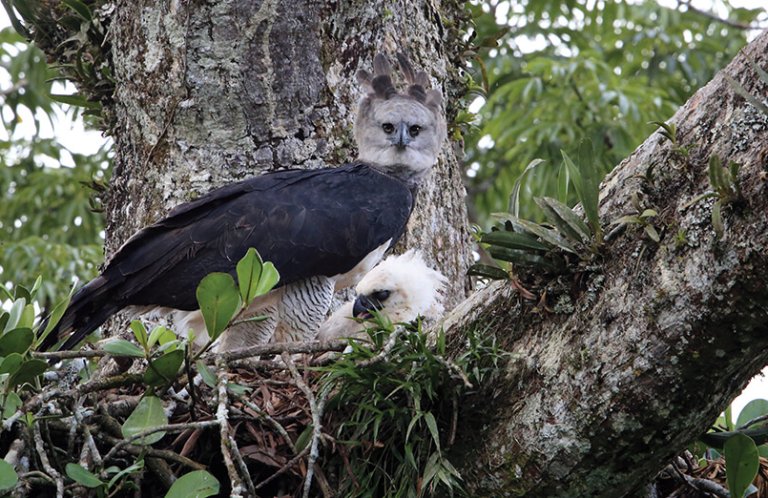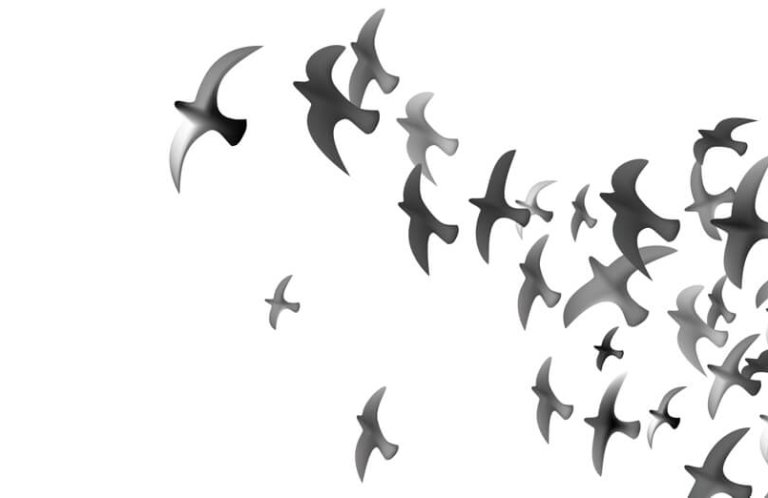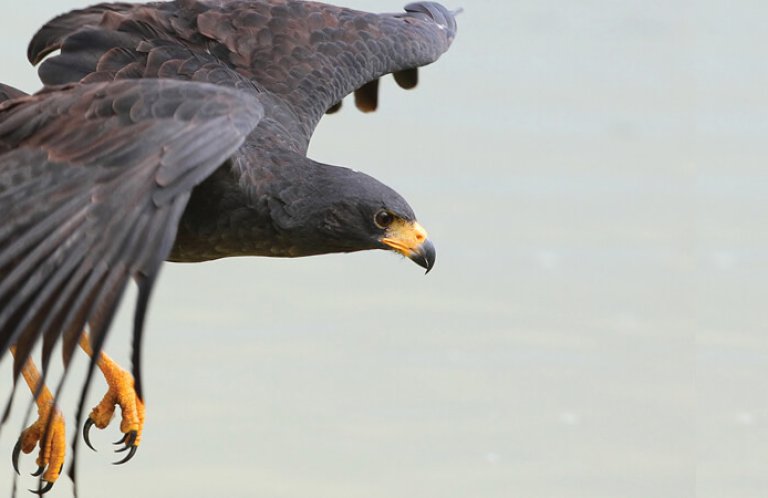Lessons From Indigenous Lifeways and Our Feathered Relatives
(Italicized words are in Chahta anumpa, Choctaw language, unless otherwise noted.)
Halito, sv hochifoyvt Aimee. Chahta micha Chikashsha ohoyo sia. Hattak Api Homma Immi foka achonachi ka isht hachi ittimanompoli la chi.
Hello, my name is Aimee. I am a Choctaw and Chickasaw woman, and I want to talk to you about the continuance of Indigenous lifeways.
In this time of crises — climate change, ecocide, declining biodiversity, social inequity and injustice — many of us are wondering how we can make a difference. While my degrees in geology and conservation biology help me to understand some of these issues, my holistic perspective as an Indigenous woman gives me a deeper understanding of how they are all connected. I want to share some of this with you, believing that an understanding of Indigenous lifeways and values can help us envision and create a better future for all of us — birds and people alike.
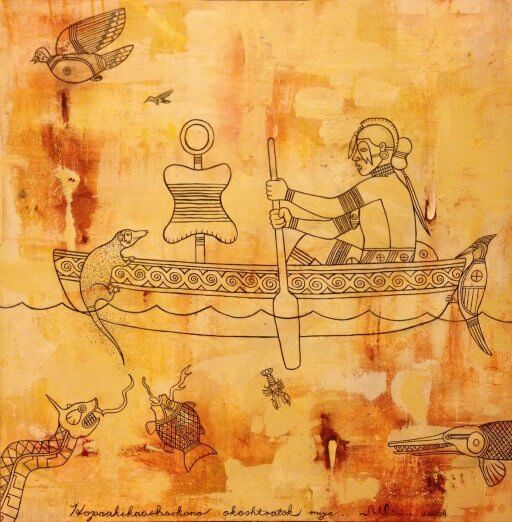
Indigenous Lifeways
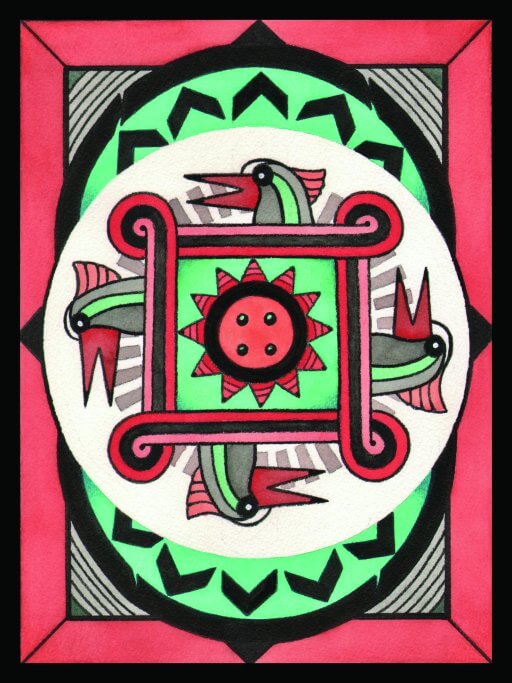
In his book “Sand Talk: How Indigenous Thinking Can Save the World,” Tyson Yunkaporta of the Apalech Clan in Australia defines “Indigenous People” as those who have a cultural memory of a sustainable way of life on the land base their ancestors occupied. He notes that each of us has Indigenous roots somewhere; some of us are just further removed from them. Indigenous lifeways and Traditional Ecological Knowledge are rooted in place and sacred relationship with the Earth, Sun, sky, water, plants, and animals, and nurtured and shared through culture, ceremony, stories, and language. The benefits of kincentric ecology (this interplay between humanity and all of the natural world) are reflected in reports from the United Nations stating that ecosystems stewarded by Indigenous People retain the highest measures of biodiversity, while a 2012 study by L.J. Gorenflo, et al., suggests that when Indigenous languages are endangered, biodiversity declines. As our elders tell us, it is from our relatives who are Indigenous to a place that we must learn how to be in right relationship with Mother Earth.
My own Indigenous roots are with the Chahta and Chikashsha people, and I am an enrolled citizen of the Choctaw Nation of Oklahoma. I also have ancestors from Scotland, Ireland, Wales, and England, further removed from their Celtic roots, who settled in the homelands of the Chahta and Chikashsha people in the 1700s. In “Choctaw Food,” Ian Thompson describes Misha Sipokni (the Mississippi River) flowing through the heart of our homelands, where hvcha (streams) and lusa (cypress swamps) once supported an incredible diversity of fish and freshwater mussels, and uski pvta (dense river canebrakes), oktak (tallgrass prairies), kowi (mixed forests), and tiak falaya (Longleaf Pine forests) were carefully stewarded by my ancestors using fire and other methods. These ecosystems supported us, the birds, and all our relatives in return.
Uprooted
Our homelands are now known as Mississippi, Alabama, Louisiana, and Tennessee, and the ongoing process of colonization has caused displacement, disconnection, and fragmentation of our people and lifeways. We — along with the land, water, and entire ecosystems — are forever changed. My ancestors were uprooted from our homelands, forced to walk “the trail of tears and death” to Indian Territory, now known as Oklahoma, after President Andrew Jackson signed the Indian Removal Act in 1830. And birds like Kiliki (Carolina Parakeet) and Ti̱kti (Ivory-billed Woodpecker) have disappeared.
In 1827, my seventh great-uncle and Chikashsha Chief Levi Colbert admonished the U.S. government while expressing his anguish over the deracination of our people:
We never had a thought of exchanging our land for any other, as we think that we would not find a country that would suit us as well as this we now occupy, it being the land of our forefathers, if we should exchange our lands for any other, fearing the consequences may be similar to transplanting an old tree, which would wither and die away, and we're fearful we would come to the same.
Prior to their displacement, some of my Chahta ancestors lived near a creek called Pachanusi (where pigeons sleep). It was named after the Pachi, or pigeon — in this case, the now-extinct Passenger Pigeon. Pachi was an important food source and a species once so abundant that their flocks darkened the sun for days as they migrated.
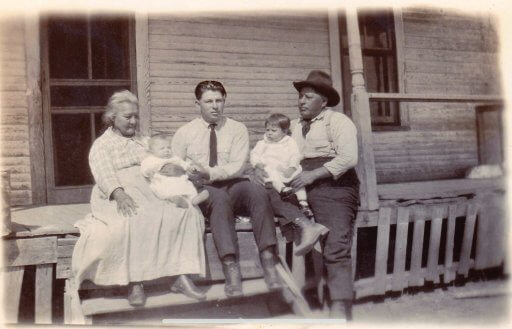
great-grandfather, Arthur William Beames (center);
and great-great grandfather, Arthur
Greenwood Beames (far right), in 1923.
Pachanusi Creek is near the Natchez Trace, where there is a National Park Service marker and sign about my sixth great-grandmother, a Chahta woman, Aiahnichih Ohoyo, and her husband, English settler Nathaniel Folsom. They kept a trading post at Pachanusi in the late 1700s and early 1800s. I think about how they relied on Pachi and how our avian relative's extinction after colonization is a terrible reminder of what happens when humans do not seek balance and harmony within our ecosystems.
The first Removal treaty imposed by the U.S. government was the Treaty of Dancing Rabbit Creek, in which the Chahta Alhíha (people) were coerced into ceding land east of Misha Sipokni for promises of payment and land in Indian Territory. My fourth great-grandparents, Amy Folsom and James Beames, were among the first to set out on the arduous journey during the devastating winter blizzard of 1831, and others from our families followed in subsequent years. In “Choctaw Food,” Ian Thompson recounts newspapers from the period describing “Chahta women as they set out gently touching the trees of their beloved homeland and telling them goodbye.”

Amy and James survived the journey to Indian Territory, but many did not. Thousands of Chahta Alhíha who attempted the journey in the summers of 1832 and 1833 died of cholera. As Jason Lewis describes in his master's thesis, “Home in The Choctaw Diaspora: Survival and Remembrance Away From Nanih Waiya,” after Removal, “Chahta Alhíha became among the most dispersed Indigenous Peoples in the United States.” By 1903, only about 1,000 Chahta Alhíha were still living in the homeland.
I am the seventh generation living away from our homelands. My parents moved from Oklahoma to Minnesota when I was a child. With that move, my family lived again near Misha Sipokni. However, most of our extended family and our Tribes were in Oklahoma, so I had limited opportunities to learn our culture and language in my youth. My Mom took us to powwows, sweats, and ceremonies with her friends and colleagues from local Tribes — Dakȟótiyapi (Dakota) and Anishinaabeg (Ojibwe and Chippewa) — and I learned about our sacred obligations in the web of life.
The Four R's of Indigeneity
Despite tremendous diversity across Indigenous lifeways, in 2004, La Donna Harris and Jacqueline Wasilewski described a concept of “Indigeneity” that had emerged from decades of collaboration with Indigenous People around the world. “The four R's” they describe are core values that are common to many Indigenous cultures — relationship, responsibility, reciprocity, and redistribution. These values help us to be good stewards of our communities and ecosystems in sacred kinship with all our relatives — whether human, bird, or tree.
During the course of my own life, birds have been important guides and have provided me with an understanding of these values. For example, as young children, my siblings and I learned about our relationships with the world around us. Every spring, we were delighted to see mama ducks emerge from their nests and make their way to the pond next to our house with fluffy ducklings in tow. Most of them were Ha̱kholba (Mallards), but occasionally Hilak (Wood Ducks) nested nearby. We chased after them in excitement. The mama duck would stand tall with her wings spread and squawk at us defensively, protecting her tiny babies. We took heed, stepping away to give them space.
One year, my Dad rescued three baby ducks whose mother was hit by a car. As surrogate mamas, my brother, sister, and I gained a greater awareness of the delicate balance of the pond's ecosystem. We noticed the remains of ducklings eaten by an owl, turtle, raccoon, or a cat. With our parents' guidance, we took good care of the ducklings until they were fully feathered. The day we released them to the pond was bittersweet, but we knew it was right. From the ducklings, we learned about our kinship obligation to respect and value all our relations.
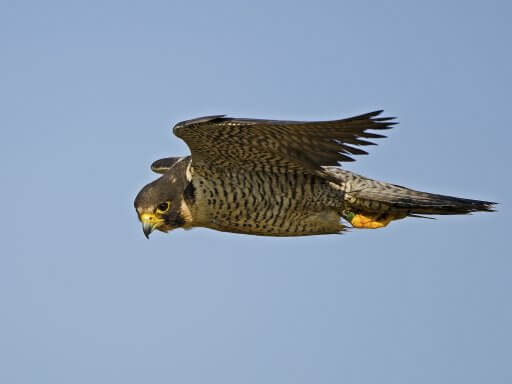
As a young adult, Oskanankubi (Peregrine Falcon in Chikashsha language) led me to the Rio Grande basin and taught me about responsibility. The Rio Grande is a place I love dearly and where I have settled for many years now. During my first job as a wildlife biologist, I canoed through Santa Elena Canyon in the homelands of the Jumanos, Chiso, Ndé Kónitsąąíí Gokíyaa (Lipan Apache), Coahuiltecan, and Mescalero Apache — a place now known as Big Bend National Park in Texas. We were observing Oskanankubi, then an Endangered species. Waking before dawn to climb from our riverside camp to the top of the tall canyon wall, we would then look across at an eyrie on the Mexican side of the river.
As I watched and listened intently, Oskanankubi wailed, taking her first flight of the day and locking eyes with me as she crossed the canyon toward us. I was mesmerized as she flew above the canyon walls tightly hugging the Rio Grande flowing between two countries and through the middle of my heart. Oskanankubi was revered by my ancient Mound Builder ancestors, representing strength, long life, family, and a long line of descendants.
I had come to the Rio Grande to observe our avian relatives because pesticides such as DDT were impacting their ability to reproduce. Birds and fish ate the insects that had been sprayed with DDT, and they were in turn eaten by birds of prey, such as Oskanankubi and O̱si (Bald Eagle), which received concentrated doses, causing their eggshells to be thin and break before their chicks were ready to hatch. Observing the decline and eventual rebound of Oskanankubi after the ban on DDT taught me about our community obligation — our responsibility to care for our relatives.
Years later, our bird kin and my role as the Rio Grande Joint Venture Coordinator brought me back to our traditional homelands — and helped me to experience the essence of reciprocity. I attended a meeting of Migratory Bird Joint Venture coordinators on Chikashsha homelands — now Memphis, Tennessee.
After the meeting, I journeyed to Mississippi — our traditional Chahta homelands, stewarded by the Mississippi Band of Choctaw Indians. The Mississippi Chahta's persistent resistance to Removal, resilience, and continual acts of community care allowed them to stay in our homelands. They were finally recognized by the U.S. government in 1945, more than 100 years after my ancestors were uprooted. I visited our Mother Mound, Nanih Waiya, the central place of creation and emergence that connects all Chahta Alhíha to a homeland. Although at the time I did not know any humans there, I was greeted by many other relatives. After the experience, these words flowed from my heart:
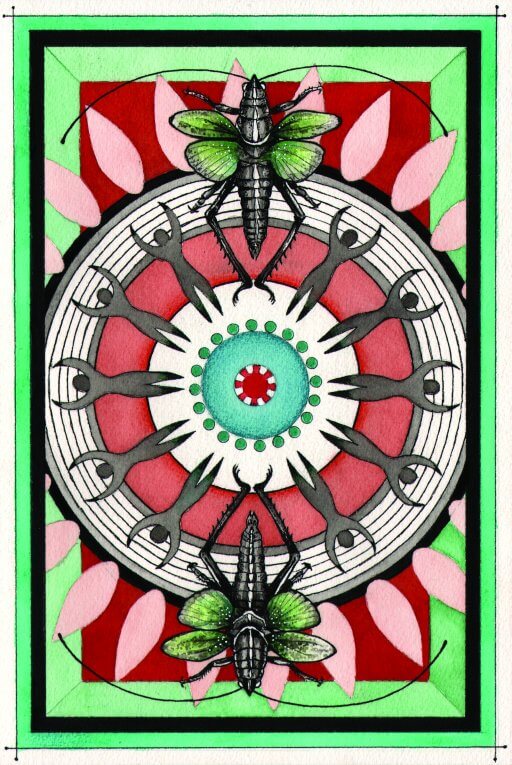
Nanih Waiya. Holitopa Ishki (Beloved Mother). My mouth finds the words as I speak softly to the Earth. Her waters call me, speaking of life and death. My heartbeat quickens as she comes into view, cloaked in green, yellow, and red grass. Nanih Waiya, Holitopa Ishki. Coming home to a place I've never been. Nanih Waiya, Holitopa Ishki. Climbing slowly, I have feelings I have never felt before. I step gingerly as I reach the top. Nanih Waiya, Holitopa Ishki. Bright rays of sunshine break through the moody clouds, piercing the fog, illuminating my mind.
Scanning the landscape, my heart delights to see Fvkit (Wild Turkeys) walking across the field below me. I drop to my knees to watch them and feel the softness of her — Holitopa Ishki. My hand touches Mother Earth, a ray of light from Hvshtahli (Father Sun) catches my eyes, and my heart bursts into flames. Holitopa Ishki. The Fvkit call to each other, slowly walking across the field toward the river. Fala (American Crow) calls from the trees. Tishkila (Blue Jay), Bishkommak (Northern Cardinal), and Hattak Lhiposh (Red-shouldered Hawk) respond. Biskinik (Yellow-bellied Sapsucker), the news bird, is drumming, announcing my presence. My heart sings. I am home.
Holitopa Ishki. A part of me lives here with my ancestors. I pull some strands of hair from the back of my head and press them into the Earth so they will not forget me. I will not forget this home. Holitopa Ishki. I lay on my back, making full contact with her. With them. My body relaxes completely. Peace washes over me. I am — we are — Earth. Holitopa Ishki. Chahta sia hoke. (I am proud to be Choctaw.)
Reconnection with my homelands lit a spark in me that intensified my learning of our lifeways and language. A year later, Jason Lewis, who works for the language program in the Department of Chahta Immi (Lifeways) for the Mississippi Chahta, asked if I would help with a dictionary project. At first, I was hesitant. How could I — just beginning to understand Chahta anumpa — help in developing a dictionary? He explained that they needed someone who knew about birds to help them match up Chahta names gathered from various historical sources with common English names used today. I felt honored to share my knowledge of birds and to give something back to Chahta Alhíha as well as our bird relatives. This was a wonderful opportunity to practice reciprocity, our cyclical obligation to contribute to the cycle of life and care for our community.
One of the birds whose name was not lost — Kofi Nukshopa (Northern Bobwhite) — has taught us about redistribution. In sacred kinship, the Mississippi Chahta continue to dance in honor of this avian relative. Kofi Nukshopa shares our traditional homelands and also the Choctaw Nation of Oklahoma's reservation. The Kofi hila (quail dance) helped revive our culture and reconnect Oklahoma Chahta with Mississippi Chahta from whom they re-learned dances, songs, and customs in the 1960s and 1970s. In this way, Kofi Nukshopa has taught us about redistribution — our obligation to share not only material wealth, but also time, talent, and knowledge.
Conserving Kofi Nukshopa (Northern Bobwhite)
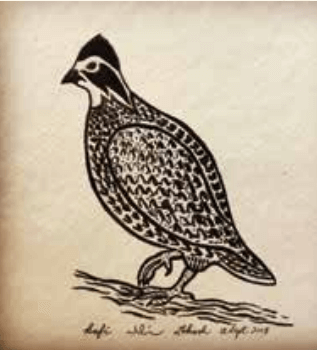
Populations of Kofi Nukshopa are declining across their homelands due to habitat loss, the use of pesticides, and climate change. ABC leads several collaborative programs in which many partners work together to restore and steward their habitats, including the Tombigbee BirdScape in the Chahta homelands of the Southeast, as well as programs implemented by the Central Hardwoods, Oaks and Prairies, and Rio Grande Joint Ventures.
In many ways, these programs reflect the “four R‘s” — core values common to many Indigenous cultures. We recognize our reciprocal relationship with Kofi Nukshopa as a food source, our responsibility to care for our avian relatives, and the importance of redistributing technical knowledge and financial assistance to land stewards who want to be good relatives.
Our Roots Are Still Alive
Recalling the words of my ancestor Levi Colbert, while some of us have indeed been transplanted like an old tree, we survived Removal, and our roots are still alive. While some traditional Chahta bird names may be lost to the ravages of colonization and displacement, others are being reconnected. As we breathe new life into our language, we also revive knowledge and lifeways, seeking balance and harmony with nature.
I hope we may find our way back to wholeness. Rekindling kincentric ecosystem stewardship, including careful tending of our gardens, communities, and lifeways, will allow us to continue to flourish. As Chikashsha author Linda Hogan writes in her book “Dwellings: A Spiritual History of the Living World”:
As an Indian woman I question our responsibilities to the caretaking of the future and to the other species who share our journeys .… It is clear that we have strayed from the treaties we once had with the land and with the animals. It is also clear, and heartening, that in our time there are many — Indian and non-Indian alike — who want to restore and honor those broken treaties.
I am grateful to be here to learn and carry on the Indigenous values and lifeways of my ancestors as I work to conserve our feathered relatives and the ecosystems we all depend on.
About the Artists: Lokosh (Joshua D. Hinson) is of Chikashsha, Chahta, Muscogee (Creek), Cherokee, and EuroAmerican ancestry and is a citizen of the Chickasaw Nation. For more information, visit: lokosh.com. Karen Clarkson is of Chahta and Cherokee ancestry and is a citizen of the Choctaw Nation of Oklahoma. For more information, see: clarksonart.com and etsy.com/shop/ClarksonArt.







































